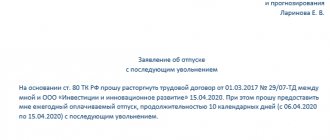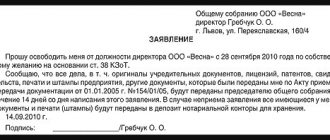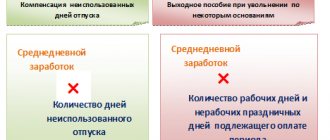Composition of payments due upon dismissal
The amounts that should be included in an employee’s calculation upon dismissal can be divided into:
- basic – mandatory for accrual;
- additional - due to the employee depending on the grounds for dismissal and the conditions of local regulations .
Let us remind you that full payment upon dismissal must be made on the date of termination of the employment relationship (Article 140 of the Labor Code of the Russian Federation).
Mandatory include :
- wages - for time worked or work performed that was not previously paid;
- compensation and incentive payments;
- compensation for unused vacation days.
What to do if payments are late
Article 140 of the Labor Code of the Russian Federation establishes clear deadlines for payments, and failure to comply with them threatens with serious consequences for the employer. In case of untimely accruals, it is the person being dismissed who suffers first of all, because he does not receive the money on time, and this, of course, affects him negatively. That is why the injured citizen himself has the primary responsibility to protect his rights.
The first thing to do if payments are delayed is to contact the employer himself, even if he is a former one, and find out why the money was not received on time. Sometimes purely technical problems arise that can be easily resolved with mutual cooperation. If the issue is not resolved in this way, then you should seek protection of your rights from other authorities that are designed to protect the rights of workers.
It should also be remembered that each day of delay must be compensated by the employer, in accordance with Article 236 of the Labor Code of the Russian Federation.
This type of penalty is assessed voluntarily by the employer without the need to go to court. A penalty is provided for each day of delay in the amount of 1/150 of the Central Bank refinancing rate on the day of payment. The stated rate applies to the entire unpaid amount.
What applies to additional payments upon dismissal?
Additional payments include severance pay , which is included in the calculation upon dismissal in the following cases (Article 178 of the Labor Code of the Russian Federation):
- when an employee is released as a result of liquidation or staff reduction - in the amount of the average monthly earnings for the first month on the day of dismissal. Also, if the employee has official unemployed status, another benefit is paid for the 2nd month , and also, by decision of the employment center , for the 3rd month (provided that the citizen has not found a job);
- a one-time benefit in the amount of average earnings for 2 weeks : if the employee refused to be transferred to another job for medical reasons and was fired;
- if the employee’s departure is due to conscription for military service;
- if the employee did not want to transfer to work in another location due to the employer’s relocation;
- if the dismissal is due to a change in the essential terms of the employment contract;
- in case of reinstatement of the former employee and termination of the employment contract in connection with this.
Also, additional accruals included in the employee’s calculation upon dismissal may be provided for in an employment contract or local regulations. For example, severance pay in a larger amount than provided for by the Labor Code of the Russian Federation, additional financial assistance.
Severance pay upon dismissal or similar payments cannot be accrued in the event of termination of cooperation with a worker for his guilty actions (Article 181.1 of the Labor Code of the Russian Federation).
Late payment of compensation
All payments by the employer must be made on the day the employee is dismissed. If on this day the employee is not at his workplace due to extenuating circumstances, then payments are made on the day specified in a separately drawn up application. In such cases, when, due to the absence of the dismissed person, the employer cannot make all the necessary payments to him and give him the work book, a notification must be personally sent to this person.
Important! If previously the calculation of wages and other accruals in the company was carried out non-cash, then, accordingly, all financial payments must be made on the day of dismissal by transfer to a bank card or personal account. The absence of an employee from the organization on this day should not in any way affect the implementation of mandatory payments.
If the payments were not made by the employer within the specified period, then each day of delay involves an additional charge of 1/150 of the refinancing rate.
How to calculate the required salary for work performed
The procedure for making calculations for dismissed employees regarding amounts due but not previously paid for time worked is determined by the company’s remuneration system.
The most common at present are time-based and piece-rate forms of remuneration. They can be used in the form of simple time-based or piece-rate systems, or in the form of time-based bonus or piece-rate systems. In the second case, in addition to the basic salary, the employee is paid an incentive portion in the form of a bonus.
Example 1
The employee's salary is 25,000 rubles. He quits in August 2020, having worked 15 working days out of 21 scheduled days for the entire month. Calculate the amount due to the employee.
Solution:
25 000 × 15 / 21 = 17,857.14 rubles.
Example 2
The employee has a daily wage of 1,200 rubles. in a day. In the month of dismissal, he worked 14 days. The rest of the employee's salary was paid earlier. Make calculations at work when dismissing a worker.
Solution:
1200 × 14 = 16,800 rub.
Example 3
From the beginning of the month until the date of dismissal, the worker produced 46 units of products. The price for it is set at 650 rubles. for a unit. How much should an employee be paid upon dismissal?
Solution:
650 × 46 = 29,900 rub.
It is possible that employees will work a certain number of overtime hours at the end of the month. In this case, such hours must be paid at an increased rate - in accordance with the requirements of Art. 152 Labor Code of the Russian Federation:
- the first 2 hours – in the amount of 1.5 parts of the salary/tariff rate/piece rate;
- other excess hours - in the amount of double salary of the tariff rate, piece rate.
Size
If the dismissal of an employee, according to the Labor Code of the Russian Federation, involves compensation for severance pay, then its amount in any situation will be the amount of wages equal to two weeks of work.
Important: if the dismissal occurs not for one’s own reason, but due to a decrease in the number of staff in the organization, then the severance pay will be one average monthly income of an employee in this organization.
In order to calculate the approximate amount of severance pay, an example calculation is given below. The resignation letter was written on October 20, the average salary is 30,000 rubles per month.
The calculation of severance pay is as follows: the employee must receive wages from October 1 to October 19, inclusive. There were 22 working days in October. Therefore, the following formula will be used for calculation: 30,000 / 22 * 18 * 0.13% (personal income tax). 18 is the number of days worked in a month for which a person should receive financial remuneration.
How to calculate incentive payments upon dismissal
The procedure for calculating the calculation upon dismissal in terms of incentive payments depends entirely on the internal regulations of the company. As a rule, they are used in the form of bonuses or allowances . Moreover, their accrual is usually a right and not an obligation of the employer. Only if the local act clearly states obligation to pay bonuses, does it pay them under any circumstances.
However, in practice, companies link the emergence of the right to receive incentive payments with the fulfillment of certain conditions . It can be:
- making a profit by the company;
- the employee’s fulfillment of the set goals;
- exceeding plans;
- no disciplinary action.
Moreover, it is permissible to indicate in the local act the possibility of non-accrual of incentive payments in cases where the employee did not fully work for the month of dismissal . Therefore, the fact that the right to a bonus arises is closely related to the content of the employer’s internal regulations.
The procedure and amount of payments are directly linked to many parameters enshrined in the company’s internal documents. For example:
- the bonus is set in a fixed amount or as a percentage of basic earnings;
- whether the incentive payment depends on the time worked in the period for its calculation or not;
- whether its structure depends on the achievement of one or more target indicators.
Example 4
The employee is given a bonus of 5,000 rubles, which depends on the time worked. The employee worked 16 out of 21 days in the month of dismissal. Determine the amount of the premium.
Solution:
5000 × 16 / 21 = 3809.52 rubles.
Example 5
The employee is entitled to a monthly bonus of 30% of his salary. Employee salary is 25,000 rubles. In the month of dismissal, 15 days out of 20 days were worked. Calculate the premium.
Solution:
25 000 × 15 / 20 × 30% = 5625 rub.
Responsibility for violation of payment deadlines
The employer's liability for late payment is not limited solely to penalties.
The management of the organization that violated the norms of labor legislation is brought to administrative responsibility in accordance with Article 5.27 of the Code of Administrative Offenses of the Russian Federation. It is expressed in the form of fines, which vary depending on who exactly is found guilty of the violation:
- Legal organizations receive fines from 30 to 50 thousand.
- Individual employers, such as individual entrepreneurs, are subject to minimum sanctions in the amount of one to five thousand.
- When punishing officials, we are talking about fines ranging from 10 to 20 thousand rubles.
The same article of the Code of Administrative Offenses of the Russian Federation stipulates that a repeated violation may allow double penalty tariffs to be applied to companies.
How to calculate vacation compensation
Here is the general formula for calculating compensation for unused vacation days:
Average daily earnings × Number of days of unused vacation |
The number of days of unused vacation is determined by the following algorithm:
Important
When calculating the vacation period, the number of days less than half a month is not taken into account, and more than half is rounded up to the whole month.
To calculate the average daily earnings, the following formula is used (Resolution of the Government of the Russian Federation dated December 24, 2007 No. 922):
At the same time, payments that are not related to wages are excluded In addition, periods of release from work for good reasons with job retention are not taken into account. And if during this time the average income was maintained, it is also not taken into account.
Thus, the billing period may include fully and partially worked months. Then the calculation of average daily earnings will take the form:
Important
If an employee quits on the last day of the month, that month is included in the calculation of average daily earnings.
Vacation pay calculation
Article 82 of the Labor Code of the Russian Federation obliges the employer, in the event of a person’s dismissal, to transfer compensation payments to him, including money for vacation that the employee did not use.
Important: compensation is made for the entire period of employment in this organization. For example, if during three years of work an employee took paid leave only once, then upon dismissal he should receive money for the rest of the leave. In this case, these are two paid vacations for each year of work.
But the legislation also provides for some nuances. If the initiator of termination of the contract is the employee himself, and the date of dismissal is not the moment of complete completion of work, for example, it is the beginning or middle of the month, then compensation for vacation will be withheld from the salary. The calculations will be equivalent to the number of days that the employee did not work until the end of the month.
The amount of vacation pay is calculated individually by the organization's accountant. Example of compensation calculation.
We take 28 days - this is the vacation period that, according to the Labor Code of the Russian Federation, every employee is required to receive annually. 28 days are divided by 12 (months) and the result is a coefficient of 2.33 - these are the vacation days that the employee receives for each month worked in the year. For example, the dismissal occurred in June, and until that time the employee was not on paid leave, which means we multiply 5 (months worked) by 2.33 and get 11.65 - these are days of unused vacation.
To calculate vacation pay, you need to multiply the number of days by daily earnings. Information about this indicator is easily calculated by an accountant, based on payslips for the year and for each month of the employee. For example, the amount of daily earnings is 900 rubles, so you need 900 * 11.65 = 10,485 rubles - this is the amount of compensation that must be paid to the employee at the time of his dismissal. Since the employment is official, personal income tax is deducted from 10,485 in the amount of 13% and the amount received is the final compensation. The employer has no right to delay mandatory payments. If such a situation occurs in the absence of compelling reasons, then the former employee has the right to seek help from the judicial authorities.
How to calculate severance pay upon dismissal
In general, the calculation of dismissal benefits is done using the formula:
Average daily (average hourly) earnings × Number of days (hours) according to the planned work schedule of the paid period |
To calculate average earnings, the provisions of the Decree of the Government of the Russian Federation of December 24, 2007 No. 922 are also used. The following algorithm is used:
They also calculate a two-week severance pay upon dismissal of an employee, as well as benefits for a month or a longer period of time.
Example 6
The employee earned 652,000 rubles 12 months before dismissal, having worked 235 days. He is entitled to two weeks' severance pay. In the two weeks following the day of dismissal – 10 working days. How to calculate benefits when dismissing a worker?
Solution:
652 000 / 235 × 10 = 27,744.68 rub.
Read also
11.06.2020
Calculation note upon dismissal - goals and design
Upon termination of an employment relationship, the law requires the employer to make a full settlement with each employee for all payments determined by labor standards. These amounts are indicated in a certificate called a settlement note.
Like other pay slips, it is issued upon the written request of the resigning employee.
Let’s clarify why the fired person may need this paper. Thus, there may be several purposes for obtaining a calculation certificate:
- if the employee wants to independently recalculate all accounting calculations;
- if he wants to know before the moment of dismissal the exact amount that he is entitled to when leaving the organization, in some cases this can help in time, without involving the court, to sort out the “errors” of the accountants on the spot, and ask all the questions to the performers;
- With this note you can confirm your last income upon new employment;
- confirm the illegality of the calculation in litigation.
In each specific option, the amount of payments is calculated based on the terms of the employment contract and the grounds for termination of the contract.
It should be noted that legislative acts do not require the use of any specific form when preparing settlement amounts. But personnel officers and accountants usually use the form of calculation note No. T-61, regulated by Resolution of the State Statistics Committee of the Russian Federation No. 1 of 01/05/2004. Since this simple template contains the most necessary information for accounting for wages.
Calculation note No. T-61 is drawn up on one sheet and includes the title side and the back:
- on the front side, basic data about the employee is entered: full name, position, department and personnel number in the internal accounting system of the enterprise;
- the basis for termination of the contract is a specific article of the Labor Code of the Russian Federation upon dismissal;
- number of vacation days, advances used;
- the number of vacation days earned during the work period;
- monthly payments are made for the billing period;
It is allowed to print out the receipt-calculation on one sheet with the back. The document is endorsed by the accountant who carries out the calculation.
Photo gallery: sample of filling out form No. T-61
The general view of the form template No. T-61 looks like this
Sample of filling out the title page of form No. T-61
This is how the back side of the T-61 form is filled out
When should the settlement be paid?
All payments due to the employee as a result of the performance of his labor function must be paid to him on the last working day. Before this date, the calculation should not be made, since until the last day the employee retains the right to withdraw his application and continue working.
Delay of wages, compensation and other payments established by local acts of the organization will be a violation of labor legislation, which may be followed by bringing the employer to administrative liability.
Natalia
Labor expert
It is important to know! Along with the payment, on the last working day the employee must be given his work book and other documents related to his work.
It might be interesting!
Can a pensioner resign without working?
Mandatory payments when settling at your own request
If an employee decides to quit, the Labor Code of the Russian Federation obliges him to notify the employer about this two weeks in advance and write a letter of resignation. Dismissal at the initiative of an employee involves legal payments:
- salaries taking into account two weeks of work;
- compensation for unused vacation days;
- bonuses, allowances established by collective agreement, accrued for time worked;
- severance benefits provided for in the contract or additional agreement upon termination of the employment relationship.
The employee will receive calculated accruals on the last day worked. Along with them, he will be given a work book with a record of a personnel inspector, income certificates 2-NDFL, personalized reports to the Pension Fund of the Russian Federation (SZV-M), and a medical book.
The accounting department will recalculate unpaid wages and compensation for unused vacation days.
Accountants will calculate the amounts due upon dismissal, but it would be useful to double-check them
The procedure for calculating wages
The procedure for calculating wages upon dismissal is related to the number of days worked in the last month. The calculation algorithm looks like this: Salary = salary / number of working days in the month of dismissal x number of days worked in the month.
To make it easier to perceive and understand the calculation of wages upon termination of an employment relationship, let’s look at an example.
Sales department manager V.I. Sidorov with a salary of 25,000 rubles, quits on January 19, 2021. In January 2021, there are 17 working days. On the day of his departure, Sidorov had worked 9 days. Thus, the salary will be: 25,000 / 17 x 9 = 13,235 rubles.
Organizations, when paying employees, use a formula supplemented by a regional coefficient, income tax, and other deductions. Salary = (salary / number of working days in the month of dismissal x number of days worked in the month of dismissal + bonuses) x regional coefficient - income tax (13%) - withholding.
The regional coefficient in the regions varies in value from 1.15 to 2. In the regions of the Far North it reaches 30% and 100% of the salary. Applies to earnings before income tax.
Deductions include:
- amounts under writs of execution;
- child support;
- compensation for losses;
- loan repayment;
- voluntary pension insurance;
- amounts issued erroneously;
- amounts at the request of the employee.
Driver Ivanov A.K. worked in Tyumen at an automobile company with a salary of 35,000 rubles. The regional coefficient in the region is 1.15, income tax is 13%, the monthly bonus specified in the employment contract is 5,000 rubles. Pays alimony for her daughter 12,000 rubles. I decided to resign on January 31, 2021. There are 17 working days in January 2021. On the day of dismissal by Ivanov A.K. 17 working days worked. Let's calculate the salary: (35000 / 17 x 17 + 5000) x 1.15 - 13% - 12000 = 46000 - 5980 - 12000 = 28020 rubles.
Video: calculation when dismissing an employee in the 1C program
Calculation of compensation for unused vacation upon dismissal
If an employee quits, then you need to either use vacation days or take compensation in cash for days not taken off. The employee is required to take 14 vacation days. When leaving work, he may go on vacation followed by dismissal. In any case, labor legislation strictly regulates this process, which employers cannot circumvent.
In 2021, the algorithm for calculating compensation payments upon dismissal remained the same, no changes occurred. This means that when calculating vacation pay, the average daily earnings algorithm is used.
Reimbursement for unused vacation = number of unused days * average daily earnings.
If vacation is used prematurely, a recalculation is carried out and the paid amount of vacation pay is withheld from the employee’s salary upon dismissal.
Number of unused days
The number of unused days is calculated based on the period of work and vacation. Typically, an employee is entitled to 28 calendar days of vacation. But if he is entitled to longer or additional paid leave, this is reflected in the calculations.
The number of unused vacation days is calculated using the formula
The following are excluded from the employee's term of service at the enterprise:
- time spent on a business trip;
- time of paid or administrative leave;
- period of temporary disability (illness, caring for a loved one, pregnancy and childbirth);
- additional free days provided for caring for disabled children;
- downtime through no fault of the employee;
- a strike in which the employee did not take part, which interfered with the performance of his work duties;
- other cases when the employee was released from work with full or partial retention of wages or without payment in accordance with the legislation of the Russian Federation.
The work period is calculated not by days, but by months. If less than half a month is worked (up to 15 days), these days are not counted. If more than half, it is considered as a full month.
Average daily earnings
Average daily earnings = accruals for the billing period / number of billing days.
The accruals include the entire labor income of the employee: salary (taking into account the coefficient), bonuses, allowances, percentage and piece bonuses, etc. Social benefits are not considered income:
- material aid;
- compensation for travel and food;
- payment of tuition fees;
- funds issued for recreation and recovery;
- money for utilities, payment for kindergarten for employees’ children, etc.
The calculation period for vacation is usually 12 months preceding the month of dismissal. If this time is fully worked, the average daily earnings are calculated using the formula: actual accrued wages for the year / 12 months / 29.3 (average number of days in a month).
If an employee does not work for the entire year, the pay period is shortened. It must include all fully worked months and remaining days. We calculate the number of days in an incomplete month: 29.3 / number of calendar days in a month x number of calendar days before dismissal or after hiring.
A billing period of less than 12 months is indicated by the manager in the order.
The table will help you correctly determine the number of allotted vacation days for different billing periods.
Examples of calculating compensation for unused vacation
Example 1. Manager of the consulting department of a law firm E.M. Larionov. hired on 02/01/2018, fired on 02/28/2018. More than half a month has been worked, so upon dismissal, compensation will be for 1 month. Number of allotted vacation days = 2.33. Larionov's salary was 70,000 rubles. Let's calculate the average daily earnings: 70,000 / 29 = 2,413.79 rubles. Compensation is calculated = 2.33 x 2413.79 = 5624.13 rubles. An income tax of 13% (RUB 731.14) is withheld from her. Larionov will receive 4892.99 rubles.
Example 2. Supermarket sales floor cleaner A.N. Vabaeva hired on January 22, 2018, fired on February 26, 2018. Worked for 1 month and less than half of the second. Refunds are due for 1 month. The calculation of compensation will be similar.
Example 3. Matveev A.I. goes on vacation from February 3 to February 14, 2021. Salary for the month worked is 41,000 rubles. (rate - 39,700 rubles + bonus - 1,300 rubles). Working on his own car, he receives compensation for fuel and lubricants in the amount of 3,500 rubles, lunches paid for by the company are 3,000 rubles. In December 2021, an additional payment for part-time work was paid - 9,000 rubles. The year before the required vacation has been worked in full.
We calculate compensation:
- We determine the estimated time period: from 02/01/2017 to 01/31/2018.
- Let's calculate the average salary. To calculate, we take the rate and bonus - 41,000 rubles, without compensation charges. (39700 + 1300) x 12 = 492000 rub. (492000 + 9000): 12 = 41750 rubles.
- Let's calculate vacation pay: (41,750 / 29.3) x 11 (vacation days) = 15,674.06 rubles.
- We calculate compensation for unused vacation payable: 15674.06 – 13% = 13636.43 rubles.










